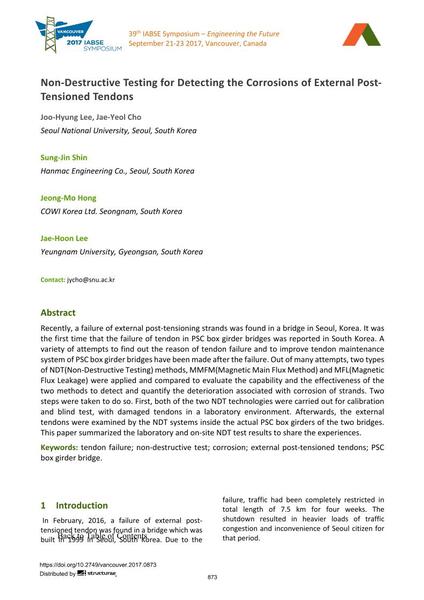Non-Destructive Testing for Detecting the Corrosions of External Post- Tensioned Tendons

|
|
|||||||||||
Bibliografische Angaben
| Autor(en): |
Joo-Hyung Lee
(Seoul National University, Seoul, South Korea)
Jae-Yeol Cho (Seoul National University, Seoul, South Korea) Sung-Jin Shin (Hanmac Engineering Co., Seoul, South Korea) Jeong-Mo Hong (COWI Korea Ltd. Seongnam, South Korea) Jae-Hoon Lee (Seoul National University, Seoul, South Korea) |
||||
|---|---|---|---|---|---|
| Medium: | Tagungsbeitrag | ||||
| Sprache(n): | Englisch | ||||
| Tagung: | IABSE Symposium: Engineering the Future, Vancouver, Canada, 21-23 September 2017 | ||||
| Veröffentlicht in: | IABSE Symposium Vancouver 2017 | ||||
|
|||||
| Seite(n): | 873-879 | ||||
| Anzahl der Seiten (im PDF): | 7 | ||||
| Jahr: | 2017 | ||||
| DOI: | 10.2749/vancouver.2017.0873 | ||||
| Abstrakt: |
Recently, a failure of external post-tensioning strands was found in a bridge in Seoul, Korea. It was the first time that the failure of tendon in PSC box girder bridges was reported in South Korea. A variety of attempts to find out the reason of tendon failure and to improve tendon maintenance system of PSC box girder bridges have been made after the failure. Out of many attempts, two types of NDT(Non-Destructive Testing) methods, MMFM(Magnetic Main Flux Method) and MFL(Magnetic Flux Leakage) were applied and compared to evaluate the capability and the effectiveness of the two methods to detect and quantify the deterioration associated with corrosion of strands. Two steps were taken to do so. First, both of the two NDT technologies were carried out for calibration and blind test, with damaged tendons in a laboratory environment. Afterwards, the external tendons were examined by the NDT systems inside the actual PSC box girders of the two bridges. This paper summarized the laboratory and on-site NDT test results to share the experiences. |
||||
| Stichwörter: |
Korrosion
|
||||
